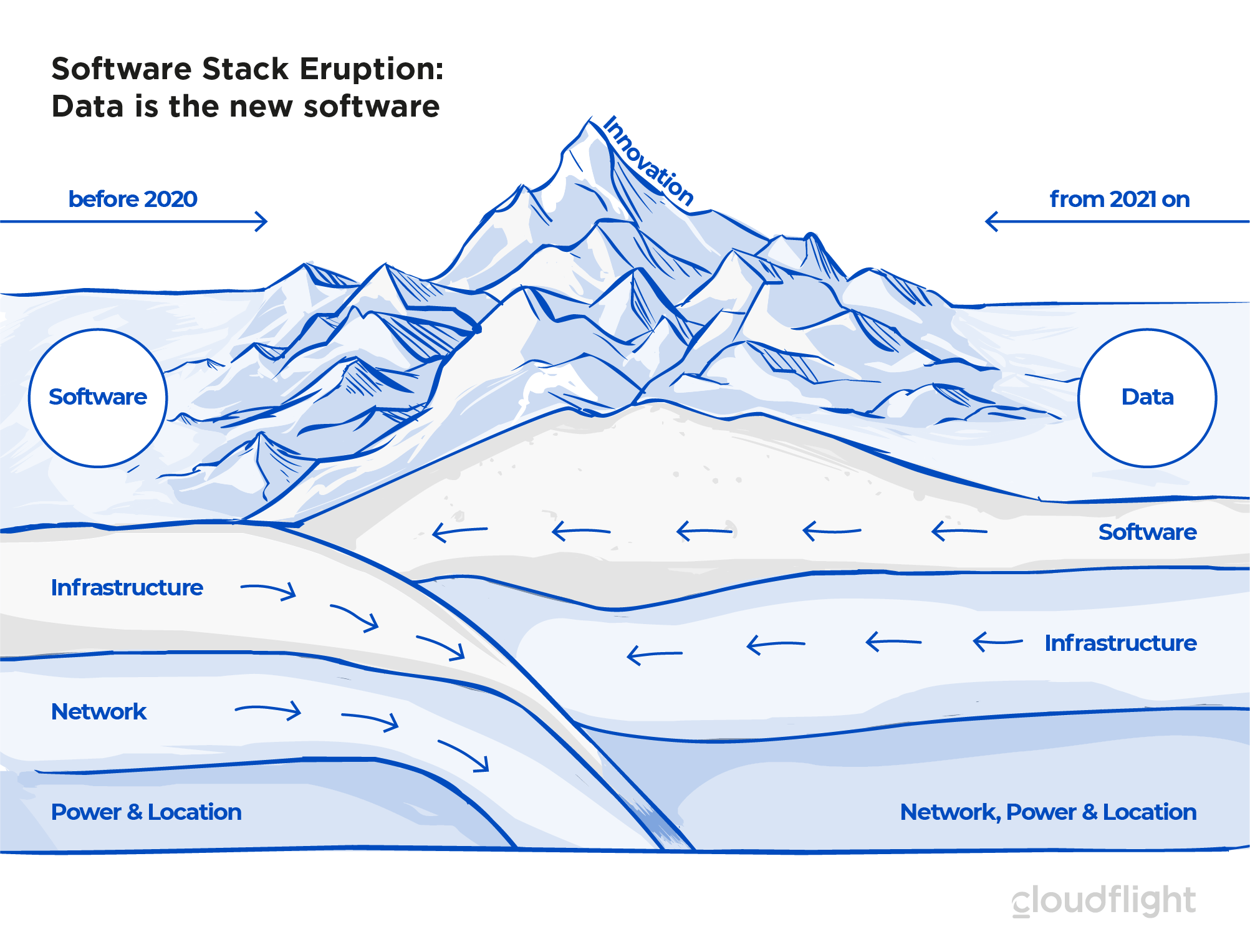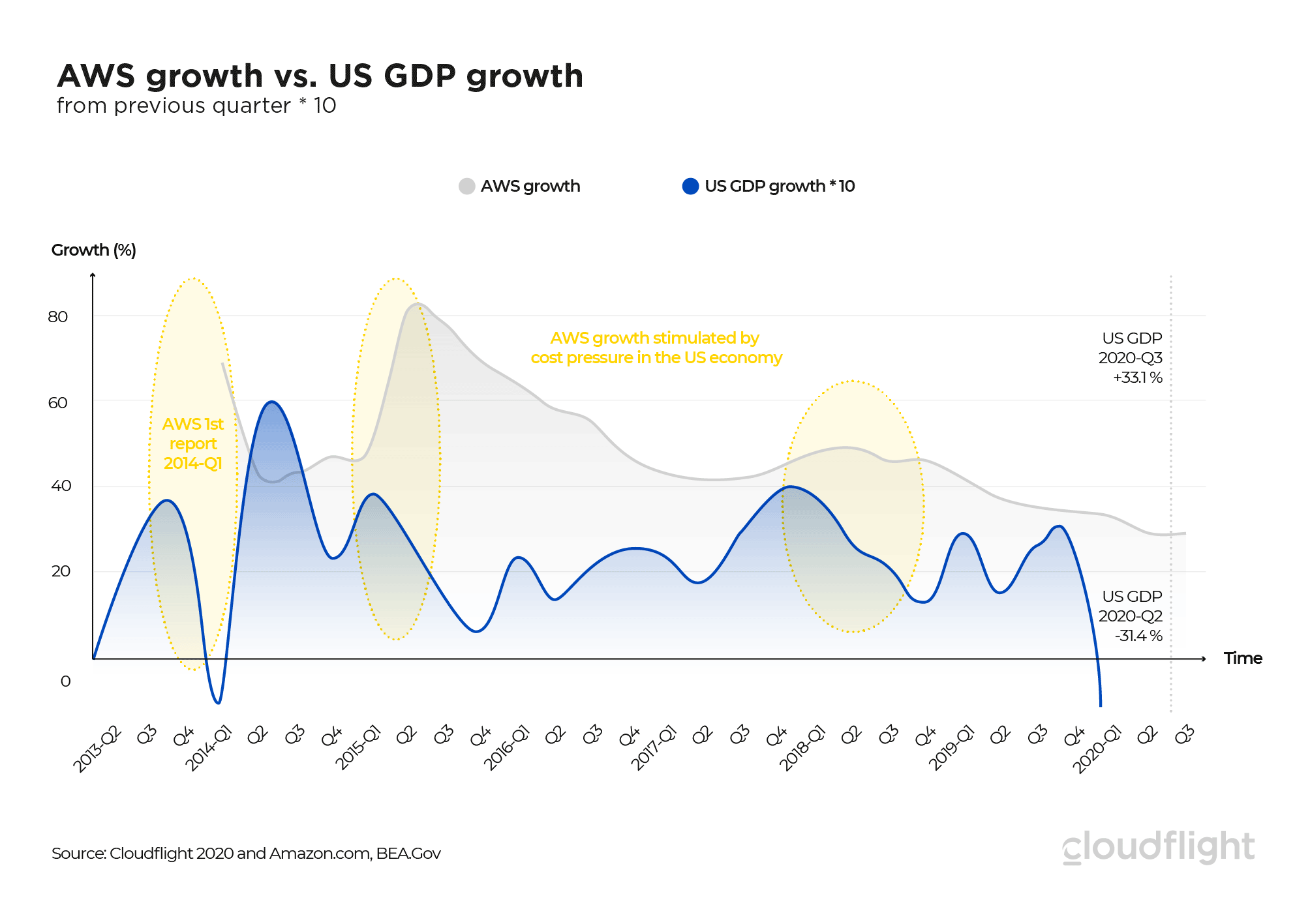With the second wave of corona, the outlook for 2021 feels more like a leap into 2030. That is how radically the technological landscape – and how we as humans deal with it – has changed and will continue to change. Who would have thought just one year ago, that even financial service providers would introduce homeoffice from one day to the next? And this is not about providing incentives or comfort for employees, but often simply about the very survival of the company.
People and society, as well as the economy and the environment, are therefore more than ever drivers of technology trends. For this reason, Cloudflight is once again establishing a link between the factors this year. Rarely in our history has there been a year in which external circumstances have changed as radically as they have in the past year of the 2020 pandemic. That’s why the acceptance or rejection of certain technologies will change as dramatically as we would otherwise experience over a five to ten-year period. And so – welcome to 2030!
People & Society – 2021 is the new 2030
An emotional leap in time in society is something new. For example, many people over 60 feel and act more like the average person over 50 from just a few years ago. These behavioural changes often become noticeable through the sudden use of new technologies, such as the booming use of e-bikes or smartphones. While these people often enjoy turning back the clock on their “perceived” age without giving up new technologies, and even use them to circumvent handicaps that have arisen, younger people don’t necessarily see it the same. For them, the sudden increase in the use of technology feels like a leap into the future without thinking about their own age. At the end of the day, the effect is the same. Many younger and older people are suddenly thinking more intensely about technology in 2021 than they had in previous years. The radical transformation caused by the pandemic intensifies this effect, which then feels like a leap in time to the year 2030 for most people in the core of their working life. Accordingly, we see the following trends for people & society in the next 12 months:
- Technology acceptance is extremely polarized
Just as political opinions are becoming increasingly polarized, the same will apply to the acceptance of digital innovation. One part of society will significantly increase their use of digital services in everyday life, while the other part will increasingly reject it. The technology-savvy part will weigh up and take risks, while the other part will categorically and aggressively demonize many of these technologies or want to prevent the general public from using them. This is where an increasing number of extreme worldviews develop and become intermingled with conspiracy theories. Compared to neighbouring countries like the Netherlands, Germany is continuously losing purchasing power for digital innovation from its own country. In the past, complete pilot versions of software (MVPs) were often used to promote user acceptance. This will become more difficult in the upcoming decade if many potential users categorically refuse to even look at and try out these products. Companies must therefore research not only business cases and requirements in their target group, but also explicit social acceptance criteria before product development. As a result, there will be target groups for the first time who consciously don’t purchase vehicles that exchange data online or who consciously avoid modern financial service providers that optimize their customers’ financial management through the use of AI. - Data protection concerns and federalism obstruct digitization
Even if a healthy level of scepticism toward global providers is appropriate, not every cloud provider is unlawful just because it comes from the USA or China. One really must take a close look here, understand contracts, security measures, and certifications, and scrutinize the providers’ business models. Many data protectionists don’t do this and stop digitization by banning all global services. Conversely, this also means that Europe will have little chance of exporting its own digital services, since by 2021 every state will consider its own data protection as the best. Therefore, even good concepts like Gaia-X cannot achieve the necessary economies of scale to become Made-In-Germany export hits.
Economy and the environment – Losers react, winners drive innovation
Without a doubt, economic recovery from the corona crisis will be the dominant topic for the next year, if not for the next ten years. Both the losers and winners in the situation are accelerating technological development:
- Corona losers react with new business models
As the pandemic will still be omnipresent in 2021, every company that has been existentially affected by corona must reinvent itself. Restaurants will become delivery services with online orders while event organizers will become commercial streaming platforms. The As-a-Service Economy replaces the former investments in order to manage the risk in the uncertain economic situation. This not only calculates services for customers based on their consumption, but also allows companies to scale all necessary resources linearly with the demand. For example, a delivery service would no longer purchase or lease its delivery vehicles as before, but would pay the vehicle manufacturer per kilometre or delivery, which is commonly referred to as Equipment-as-a-Service. This of course also applies to IT. For this reason, Cloudflight sees a further decrease of corporate or regional data centres and a disproportionate growth in global public cloud infrastructure providers such as AWS, Azure, GCP, Alicloud, and Tencent. They are growing so fast that their prices are almost decreasing with Moore’s Law, or performance increases and they are thus known as hyperscalers. Historically, one can see that massive cost pressure in the US economy has always been a growth driver for Amazon Web Services (see Figure).
The European economy, however, was still doing so well in the past crises that it would not have dared to make radical changes to its IT. This will be different now! Part of the European economy is being hit so hard by the pandemic and the hyperscalers have now fully implemented the EU privacy requirements. As a result, we initially expect the same effect in Europe in 2021 as was the case in the USA in 2013, 2015, and 2018.
- Corona winners invest proactively in their technological lead.
One should not forget that many industries have benefited enormously from the pandemic. This includes online retailers, logistics companies, delivery services, and all those involved with protective clothing and hygiene articles. The IT sector is also booming, with video services, network component providers, and telecommunications companies. All these companies will invest their profits massively in 2021 in business model and technological development, in order to get ready for the new competitive situation after corona. The so-called Circular Economy will play an important role in the business models and, for example in B2B, will yield new deposit and packaging solutions that bring added value with IoT Tracing. Overall, the corona winners will be able to invest in both sustainable and disruptive technology. For example, increasingly intelligent waste sorting systems will enable more upcycling of raw materials. In less densely populated areas, the first delivery drones are being deployed as prototypes, which will then spread productively in 2022.
Software landscape overall – tough times for ERP systems
Driven by the corona winners, the software landscape in companies will continue to change:
- Consolidated market leaders write their own business software
Industry leaders such as Otto or Lidl have already started this trend in recent years, which is traditionally known from the financial sector. Next year, more and more companies will question the costs of implementing and maintaining ERP software packages and will design alternative business software based on Open Source Platforms or Platform-as-a-Service services offered by hyperscalers. - Hardware/software – appliances break
In many areas, such as the automotive industry, but also in consumer products, software traditionally came from the manufacturer “embedded” within the hardware. While hardware is developing continuously and more slowly, software will make the bigger leaps next year. Many OEMs are therefore trying to develop the software themselves, like Volkswagen with its CarOS, or to obtain it from software partners, like Daimler in its partnership with Google/Waymo. Nevertheless, one still needs considerable experience to build computing power and control devices for the tough conditions in vehicles or industrial plants. Suppliers like Bosch or Continental have a difficult decade ahead of them, in which they have to prove themselves in a new ecosystem through their own software innovations.
Cloud Computing Adoption – The crisis accelerates the consolidation
Cloud computing will be the driver of the next Software Stack innovation again in 2021.
- Software Stack Eruption – data is the new software
We know the sudden shift in hardware technology, which is constantly evolving according to Moore’s Law. Nevertheless, technology is rapidly being replaced in certain applications. In recent years, for example, data tapes have been replaced by large volume spinning disks for many archiving tasks in data centres, while the SSD has overtaken these hard drives from servers and laptops. Ultimately, high-performance servers, which initially used the first expensive SSDs for data storage, now use large RAM volumes to store modern in-memory databases. Cloudflight sees the start of a similar but much more significant eruption next year. The role of software, with its quality and functionality, will be replaced by data. Here a whole class of data products, data management platforms, data development platforms, data virtualization platforms, or already completed training data for the common machine learning algorithms is being developed. Die OpenAI Initiative shows us that algorithms have to further develop with the appropriate amounts of data. Simply collecting data does not result in a breakthrough. However, programming only with simulations without real data will clearly reach its limits in the upcoming decade. The decisive factor is therefore the swift collection of sufficient, good-quality learning data or an appropriate business model in the new ecosystem of data on a modern Software Stack. Traditional software outside of machine learning and artificial intelligence, is becoming increasingly commoditized and will be replaced by the orchestration of PaaS services. Software services continue to take the place of infrastructure. The traditional infrastructure, especially with compute services, is being further abstracted and is taking the place of the former network. Networks, on the other hand, continue to consolidate with location services such as power supply or cooling:

- Hybrid cloud and multi cloud – fast forward to PaaS
Using private and public clouds or several public clouds at the same time for an application landscape has been much discussed up to now but was operationally the exception – in 2021 it will become the norm. The abstraction of the various cloud infrastructures with container management based on Kubernetes helps here, as does special software frameworks like Google’s Anthos or Microsoft’s Azure Arc, which, however, still need to be expanded in terms of application scenarios and their degree of readiness. Users will also use hybrid PaaS services in 2021. These are software services that transparently offer an integrated management environment across multiple hyperscalers, such as the recently announced version of MongoDB’s database service Atlas. In 2021, private clouds will be seamlessly integrated into the PaaS management tools like an additional public cloud provider.
IoT is fully integrated into the “Anywhere Computing” continuum
IoT will not only be a mainstream technology in 2021, it will also establish itself as the outer rim of edge computing. Although it will still take a long time before all existing industrial plants are online, from 2021 virtually no new machines or cars will be built that don’t have an online option when ordering. With this process, the special status of IoT devices disappears.
- IoT becomes the physical surface of “Anywhere Computing”
In 2021, all public cloud hyperscalers (AWS, Azure, GCP) will offer the entire continuum from public clouds to edge computing via cloud regions, smaller local instances, mini-instances in the telco networks, various forms of edge computing in companies, as well operating systems on very small IoT devices. Edge computing is no longer an island, but rather an integrated part of a larger topology. This continuum ultimately made it considerably easier to combine autonomous capabilities on the edge with large amounts of data and AI processes in the public cloud. This paves the way for autonomous robotics and vehicles on a large scale. - 5G mobile communications continue to struggle in Germany
Whilst the telecommunications companies are extremely profitable, there is no nationwide 5G coverage that is comparable to our neighbouring countries. The reasons for this continue to be incorrect regulations and political lobbying. Larger companies are thus partly investing in 5G campus networks as an alternative or supplement to WiFi infrastructures with multiple privacy perimeters. As it was the case in the US last year, edge computing in 5G infrastructure branches is becoming part of the Anywhere Computing trend in Europe.
Artificial intelligence and machine learning are becoming the growth drivers
The above-mentioned mega-trend of software Stack Eruption already describes the momentum surrounding artificial intelligence and machine learning. The companies that developed strategies for collecting learning data from all customers at an early stage are now in the home stretch:
- In 2021, 30% of the AI/ML projects will be implemented productively in DACH
The days of unsuccessful pilots and MVPs are a thing of the past. This adoption spans across all areas, B2B and B2C. In the consumer market, real-time translation apps are seeing a breakthrough – as soon as we can travel again. Autonomous driving in Europe in 2021 will not be able to reach the level it has in the USA and China, where you do not need to have your hand on the steering wheel for longer periods of time. In our country, the legal concerns are far from being resolved and are blocking innovation on public roads. Clearly defined EU approval regulations and auditable tests for autonomous vehicles are overdue. - Voice is the new mobile
It took almost 10 years for the form factor and the interaction of smartphones and tablets to slowly eat their way through from content websites to e-commerce and ERP systems. Just as disruptive, but much faster, “Voice-as-UI” is now coming to the user experience. Amazon’s Alexa is the classic example of the innovator’s dilemma. Initially limited and coming from the consumer sector, voice interfaces are developing so quickly that they will soon overtake certain user interactions in the business sector. Even if it’s irrelevant now for artificial intelligence whether it communicates with people using natural language or text, natural language finds a faster user acceptance. This will be further intensified by the corona-related demand for touchless UIs. Text-based chatbots continue to fall short of expectations.
The year 2020, which is coming to an end, was firmly in the grip of the pandemic and will therefore result in an extremely bad start for the next decade. The pandemic won’t be over in 2021, but we will have learned to live with it and to change our lives – even radically in some cases. That’s why we will be taking a huge step forward in 2021 and breaking old habits. Many CIOs and software architects feel like the world as they know it is disappearing very quickly. However, a new technological world with new rules is already emerging behind it. The data ecosystem is becoming more important than the innovation in software engineering alone. Economies of scale on data across individual customers are even more important than the well-known economies of scale on software operations, which have helped hyperscalers achieve their breakthrough over the past decade. Ultimately, many companies find themselves unexpectedly at the crossroads of their existence. While you can close a restaurant for one year and the food will be just as good when you reopen, technology companies are fundamentally different. The speed of innovation is not slowing down, neither in the USA nor in China. As a consequence, if the pandemic were to lead to a further delay in the digital economy, our latecomer position would develop into a chronic structural problem in Europe. Here, the German and Austrian industry needs a more disruptive innovative spirit according to the motto “Uber yourself before you get Kodaked”.
In a second attempt, Cloudflight wishes you an innovative start in the new decade – with a one-year pandemic delay.

